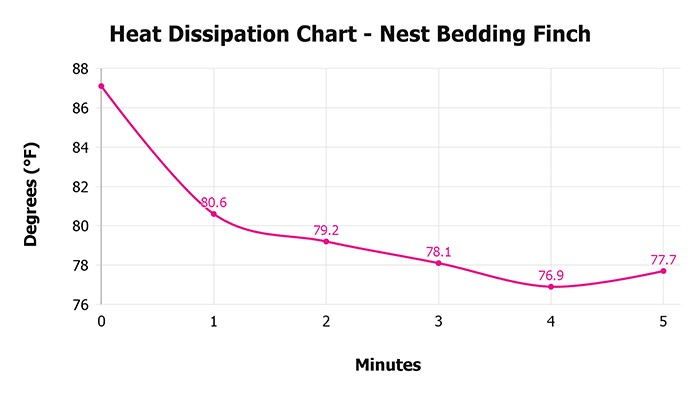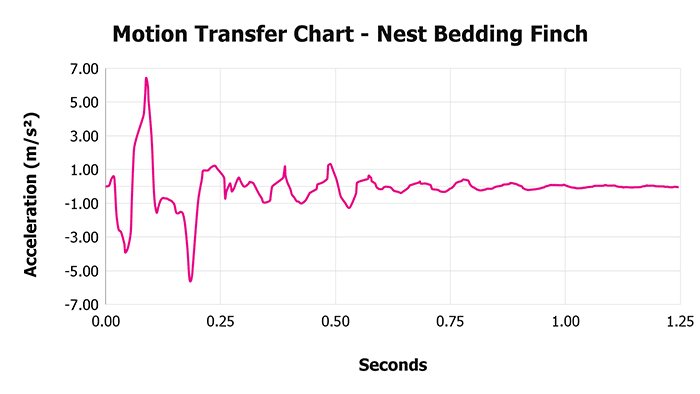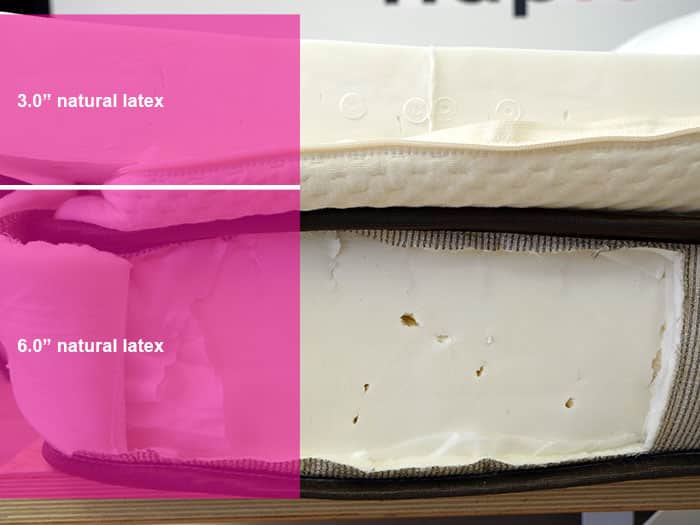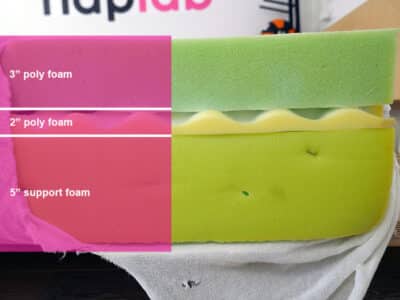
Best For
- Uses natural latex for comfort & support layers
- Excellent cooling due to latex
- Super fast response time
Considerations
- High motion transfer, may not be great for all couples
- Edge support for both sitting and lying is good, just not great
Our Verdict
The Nest Bedding Finch is a natural latex mattress made of 100% natural Talaly latex.
It has a simple two-layer design with a quilted cover for added softness. This mattress is a 5 out of 10 on the firmness scale, but is also available in a firmer version—around 7.5 out of 10 (where 10 is the most firm).
The Finch offers sleepers a moderate level of sinkage with a generalized contouring hug around the body. It also provides low bounce, which can make it a little more difficult to move around on.
Based on our performance tests, the Finch earned an overall score of 8.67. This ranks it among the top 50% of all mattresses tested to date. However, from a pricing standpoint, the Nest Bedding Finch is substantially more expensive than the average mattress.
At $2,149 for a queen-size Finch model, this mattress is 47% more expensive than average. When looking at just latex foam models, this extra amount is only 33% more expensive. While the Finch is a solid mattress in many areas, the price to overall performance is not among the best we’ve reviewed.
Type: Latex Foam
Firmness: Medium (5) and Slightly Firm (7.5)
Best For: All Sleeping Positions, All Body Weights
In This Review
Performance Tests | Firmness | Support & Sleeping Positions | Design | Materials | Comparisons | FAQs
Performance Tests
At NapLab, we put each mattress to the test.
We test 10 different factors that impact the performance, comfort, and value of the mattress. We then take the results of that test and compare to every mattress we’ve tested to date.
Check out the full performance table below to see how this mattress ranks:
| Factor | Nest Bedding Finch | Average |
|---|---|---|
| Overall Score | 8.67 | 8.55 |
| Price (Queen) | $1,997 | $2,028 (Latex Foam only) |
| Cooling – Score | 9.0 | 8.7 |
| Sinkage – Depth | 2.03″ | 2.15″ |
| Sinkage – Feel | Moderate | Moderate |
| Motion Transfer – Score | 6.9 | 8.2 |
| Motion Transfer – Acceleration | 11.89 m/s² | 8.68 m/s² |
| Response Time – Score | 9.9 | 8.9 |
| Response Time – Mostly Recovered | 0.2 sec. | 0.4 sec. |
| Response Time – Fully Recovered | 0.4 sec. | 0.9 sec. |
| Bounce – Height | 7.72″ | 9.72″ |
| Bounce – Feel | Low | Moderate |
| Edge Support – Score | 7.8 | 8.6 |
| Edge Support – Sitting | 5.00″ | 4.05″ |
| Edge Support – Lying | Good | Good |
| Sex – Score | 7.6 | 8.5 |
| Pressure Relief – Score | 9.0 | 8.8 |
| Comfort Layer Thickness | 4.5″ | 4.1″ |
| Mattress Thickness | 10.5″ | 12.0″ |
| Off-Gassing – Score | 10 | 8.4 |
| Off-Gassing – Smell | None | Strong |
| Off-Gassing – Days | 0 days | 6 days |
| Company – Score | 10 | 8.8 |
| Trial | 365 nights | 169 nights |
| Warranty | Lifetime | 25% have lifetime warranties, average of other 75% of mattresses is 13 years |
How is Nest Bedding Finch Different?
The Nest Bedding Finch has overall performance that is slightly below average, but with a price that is also slightly below average—2% less than the average latex foam mattress for a savings of $31 (for a queen mattress).
Advantages
The Finch has slightly better cooling performance, fast material response time, and a thicker layer of comfort materials.
Neutral Factors
This mattress also has 7% less sinkage and 20% less bounce than average. Both sinkage and bounce are more preferential factors, but still certainly worth considering.
Disadvantages
Disadvantages for the Finch include 40% higher levels of motion transfer, and 20% poorer edge support. The sex score also struggled a bit, largely due to the lower levels of bounce.
Testing Note: In our performance tests of the Finch, we tested the medium firmness mattress.
Cooling Test
Cooling on the Nest Bedding Finch mattress was excellent. During our tests, I found the Finch breathed incredibly well and did not retain heat.
Baseline Temp.
73.4°F
Max. Temp.
87.1°F
Ending Temp.
77.7°F
At no point during the tests did I feel any significant heat build-up. When it comes to cooling, latex mattresses have a significant leg up over memory foam and poly foam mattresses.
Max. Temp.

Ending Temp.

- Baseline Temperature – the temperature of the mattress before anyone lies on it
- Maximum Temperature (0 minute) – the temperature of the mattress after lying on it for 15 minutes
- Ending Temperature (5 minute) – the temperature of the mattress after being lied upon and having no one on it for 5 minutes
Latex doesn’t absorb heat in the same way that other foams will. The material construction of the Finch mattress is a 1.5” quilted cover on top of 9.0” of natural Talaly latex.
The latex is perforated with holes to further improve breathability. This fact, combined with the material’s ability to avoid retaining heat, works together to great effect in order to keep sleepers cooler.
Heat Dissipation Over Time

Sinkage Test
The Nest Bedding Finch mattress has a moderate level of sinkage. In our tests, we measured 2.03” of pressure point sinkage.
Sinkage Depth
2.03″
Sinkage Feel
Moderate
Body Contour
Slight
The level of sinkage is documented in the image below.

On average, across all mattresses we’ve tested to date, we see a sinkage depth of 2.22”. So the Finch is a little below average, but still very much with what we would consider a “moderate” sinkage depth.
At 2.03” most sleepers will find it comfortable. The contour on the Finch mattress is notably more generalized around the body.
This is in contrast to the type of contour and hug that memory foam creates, which is more dramatic and exacting around the body.
There isn’t really a good or bad when it comes to the type of contour a foam creates, but some sleepers may find the contour of memory foam to be too significant.
Motion Transfer Test
Motion transfer on the Nest Bedding Finch mattress was high. In our tests, we measured an acceleration range of 11.89 m/s².
Accel. Range
11.89 m/s²
Motion Duration
0.92 seconds
The level of motion transfer is documented in the video below.
This is more than double the average motion transfer in all of our tests to date, which is 5.89 m/s². Natural latex as a material simply has lots of bounce and is highly responsive.
As a result, it naturally creates more motion transfer than many memory foam and poly foam mattresses. If you or your sleeping partner are highly sensitive to motion transfer you may want to consider a different mattress.
Motion Transfer Over Time

The Awara (3.72 m/s²), Birch Luxe 5.41 m/s²), and EcoSleep Hybrid (5.96 m/s²) mattresses all utilize latex, but also have considerably less motion transfer.
Response Test
The Nest Bedding Finch mattress has a very fast response time. In our tests, we measured a mostly recovered response time of 0.2 seconds, with a full material recovery taking just 0.4 seconds.
Mostly Recovered
0.2 sec.
Complete Recovery
0.4 sec.
The level of responsiveness is documented in the video below.
This is among the fastest mattresses we’ve tested to date and significantly better than the average.
Average response time across all mattresses we’ve tested to date is 0.58 seconds to mostly recovery and 0.94 seconds to fully recovery.
Mattresses with a faster response time are easier to move around on and avoid any type of “stuck” or overly enveloped feeling.
Bounce Test
The Nest Bedding Finch mattress has a moderately high level of bounce. In our tests, we measured a total bounce height of 7.72”.
Max. Depth
5.22″
Max. Rebound
2.50″
Total Bounce
7.72″
This is notably lower than the average bounce height across all mattresses we’ve tested to date, which is 9.39”.
Max. Sinkage Depth

Max. Bounce Height

The level of bounce is also documented in the video below.
I was more than a little surprised by the relatively low bounce height. Typically, latex mattresses have substantially more bounce on average compared to most other mattress types.
The slightly softer firmness of the Finch mattress (at least in the medium version) is the most likely reason for the diminished level of bounce. Despite having a little less bounce, it’s just a little outside of what I would call a moderate bounce level in the 8-12” range.
I would expect a little more bounce in the firm version of the Finch mattress.
Edge Support Test
Edge support on the Nest Bedding Finch mattress leaves much to be desired. In our sitting edge support test, we measured 5.0” of sinkage compression.
Max. Sinkage
5.00″
Lying Support
Good
Reinforced Edge
No
This is a little deeper than the average sinkage of 4.67”. However, being just close to average isn’t great when it comes to edge support.
The level of edge support while seated is documented in the images below.
Sitting, 140 lbs.

Sitting, 200 lbs.

In general, the best mattresses have a sitting edge compression of 4.0” or less. As you can see from the photographs there is a significant collapse of materials when sitting directly on the edge.
This is a relatively common problem with natural latex, but especially latex that’s slightly softer, as the Finch is.
Edge support while lying on the mattress is a similar story. It feels as if the mattress is trying to roll you off when lying directly on the edge.
The level of edge support while lying is documented in the images below.
Lying on Edge, 140 lbs.

Lying on Edge, 200 lbs.

Sex Test
The best mattresses for sex have high bounce, good edge support, quiet materials, and good pressure relief and cooling.
These 5 factors make up the NapLab sex performance score.
| Sex Factor | Factor Weight | Score | Rating |
|---|---|---|---|
| Bounce | 65% | 7.3 | Moderate |
| Edge Support | 20% | 7.5 | Fair |
| Noise | 5% | 10 | Minimal |
| Pressure Relief | 5% | 9.0 | Excellent |
| Cooling | 5% | 9.0 | Excellent |
Sex performance on the Nest Bedding Finch is a bit of a mixed bag. In many cases, more bounce on a mattress is better for sex.

The bounce on the Finch is pretty restrained — not low bounce, but certainly not high bounce either. Hybrids or coil-based mattresses would outperform the Finch in this area.
Edge support is also a little lacking. While this may not be an important factor for all couples, it’s important to many.
Pressure, relief, cooling, and noise were all well-performing factors. No issues to note here.
Pressure Relief Test
Pressure relief on the Nest Bedding Finch mattress was excellent. Out of all of the mattresses I’ve tested over the years I continue to be impressed with the quilted covers that Nest Bedding uses.
Comfort Layer
4.5″
Support Layer
6.0″
Notably, the quilted cover on the Finch isn’t quite as good as the Nest Bedding Sparrow’s quilted cover. Even so, it’s better than most and offers fantastic pressure relief.

The quilted cover combined with 3.0” of natural latex foam work together to create a generalized contour around the body, relax muscles, and create ideal pressure relief.
Off-Gassing Test
There was no significant off-gassing or smell with the Nest Bedding Finch mattress. Immediately after unboxing the mattress, we conducted our smell test.
Initial Smell Strength
None
Off-Gassing Period
0 days
During that test, we confirmed there was no strong off-gassing smell. Sometimes latex mattresses can have a fairly strong rubber smell.

However, we did not even experience that. The Finch mattress is ideal for sleepers who are sensitive to strong odors.
Company
The company score takes a look at factors that may influence your experience with the mattress.
Factors include length of the trial period, warranty, shipping / return costs, and country of origin.
| Company Factor | Factor Weight | Score | Data |
|---|---|---|---|
| Returns | 40% | 10 | $0 |
| Trial Period | 30% | 10 | 365 nights |
| Warranty | 20% | 10 | Lifetime |
| Shipping | 10% | 10 | $0 |
| Country of Origin | 0% | USA |
Nest Bedding was founded and launched its first mattress in 2011. The company policies at Nest Bedding are consumer-friendly and generally fair.
Nest Bedding has a 365-night trial period, which is among the ranks of some of the best trial periods in the industry. They also include a lifetime limited warranty.
Shipping is free and returns are free. In addition, all Nest Bedding products are sourced, designed, fabricated, and shipped from within the US.
How firm is the Nest Bedding Finch?
The Nest Bedding Finch is available in two firmnesses—medium and firm. We tested the medium version, which came in around a 6 out of 10 on the firmness scale.

I would expect the firm to be closer to a 7.5 out of 10.

Support & Sleeping Positions
Support on the Finch mattress was excellent overall. During our tests, I felt well supported (except when lying and sitting directly at the edge). Despite the issues with edge support, general support is solid.
| Support Factor | Data |
|---|---|
| Comfort Layer | 4.5″ |
| Support Layer | 6.0″ |
| Firmness | Medium, and Slightly Firm |
| Body Contour | Slight |
| Zoned Support | No |
| Reinforced Edge | No |
The Finch Medium is best for the following sleepers:
| Sleeper Weight | Stomach Sleepers | Side Sleepers | Back Sleepers |
|---|---|---|---|
| Under 150 lbs. | Yes | Yes | Yes |
| 150-250 lbs. | Yes | Yes | Yes |
| 250-300 lbs. | Yes | Yes | Yes |
The Finch Firm is best for the following sleepers:
| Sleeper Weight | Stomach Sleepers | Side Sleepers | Back Sleepers |
|---|---|---|---|
| Under 150 lbs. | Yes | Maybe | Yes |
| 150-250 lbs. | Yes | Maybe | Yes |
| 250-300 lbs. | Yes | Yes | Yes |
My only concern is when it comes to supporting heavier sleepers. The slightly softer feel of this natural latex may result in heavier sleepers sinking considerably deeper into the foams.
As you can see from the photographs where we have the 60-pound weighted vest on, there is a considerable sinkage even at 200 pounds.


Heavier weight sleepers than sleep on their back and stomach, in particular, may find the Finch mattress (at least in the medium) isn’t supportive enough.
If that’s you, you may want to consider the Winkbed Plus, Helix Plus, or Titan Hybrid Luxe mattress, all of which are designed for sleepers over 300 pounds. Alternatively, the Finch mattress in the firm version will also provide additional support.
Design
The design of the Nest Bedding Finch is a natural latex build with a 10.5″ profile and two optional firmnesses available. Here is a quick look at what the Finch is made of:
| Design Factor | Data |
|---|---|
| Type | Latex Foam |
| Thickness | 10.5″ |
| Cover Type | Pillow Top |
| Weight | 120 lbs. |
| Has Handles | Yes |
| Fiberglass-Free | Yes |
| Ships in a Box | Yes |
It uses two layers of natural latex and encases those layers in a soft, quilted cover.

Materials
From top to bottom, there are three layers to the Nest Bedding Finch mattress. The layers break down as follows:
| Layer Type | Thickness | Layer Specs |
|---|---|---|
| Pillow Top | 1.5″ | 1.5 PCF |
| Talalay Latex | 3.0″ | 28 ILD |
| Talalay Latex | 6.0″ | 36 ILD |

The Cover
The cover on the Finch mattress is soft and stretchy, with a diamond stitiching pattern to hold the quilted material in place.

One of the most unique parts of the Nest Bedding Finch is the zippered cover. This zipper allows for easy access to the top layer of foam.
If you try one mattress and decide that it’s not the right firmness for you, it is incredibly easy to just unzip the cover and swap out that top piece of foam for a firmer or softer option (depending on what mattress you started with).
Not only does this improve the likelihood of the mattress working for you, but it also extends the overall life of the mattress since you can replace that top foam as needed.
Nest Bedding will send you one replacement latex top layer during the life of your mattress as part of their Lifetime Renewal Exchange program (more on that program below).

Lastly, on the side of the mattress, there are thick quilted handles that make it easier to move the mattress around as needed.
The Comfort Layer
The top layer of the Finch is a simple perforated Talalay latex. This design improves airflow, and also gives it a softer feel than solid foam layers.

The Support Layer
The support layer is 6.0″ of natural Talalay latex. This layer, is non-perforated, unlike the top layer, which makes it more of a high-density foam with a firmer feel.

Despite the different looks, both materials are Talalay latex.
Product Evolution
Nest Bedding was first launched in 2011, but recently underwent a pretty large rebranding effort in 2021.

During this process, all Nest Bedding mattresses received a new name. For example, the FLIP Hybrid became the Robin. And the Natural Latex mattress became the Finch, as reviewed here.
The Finch also received a new cover and changed the type of latex used in early 2023. The mattress was originally made with Dunlop latex, but in 2023, the brand made the shift to Talalay latex.
The Talalay latex still allows for perforated latex on the top and support latex below so performance would be expected to be similar.
For clarification, the performance tests in this review analyzed the Finch mattress with Dunlop latex.
Other Mattresses to Consider
Still not sure if the Finch is right for you? Here are three other options you may want to consider.
For Hybrid

Nest Bedding Owl
Natural Latex Foam + Coil
The Owl, also by Nest Bedding, uses natural latex and coils, which provides more bounce than the Finch as well as improved edge support (4.75″ max sinkage on the Owl compared to 5.0″ on the Finch).
For Flippable Design

Nest Bedding Robin
Plush, Quilted Cover
The Nest Bedding Robin is a flippable hybrid. This mattress has two firmnesses—6 out of 10 and 8 out of 10. It doesn’t use latex foam, but instead has a gel foam and support foam combo as well as the pocketed coil core.
For Poly Foam

Nest Bedding Quail
A 3″ Poly Foam Comfort Layer
The Nest Bedding Quail mattress is 100% foam, like the Finch, but does not use natural latex. Instead, the Quail uses a poly foam with a convoluted foam middle layer. Overall, it had a good score (9.04 on our performance tests.)
Frequently Asked Questions
Still have questions? Check out some of the top FAQs on the Nest Bedding Finch mattress below and get the answers you’re looking for.
Here are the current prices, with any sales or promotions reflected below:
Twin: $999
Twin XL: $1,159
Full: $1,439
Queen: $1,679
King: $1,999
Cal. King: $1,999
*Note: Sales prices are subject to change without notice or warning.
The trial is 365 nights, with a 30-night adjustment period.
If after the first 30 nights, you still don’t love it, you can request a return. Shipping and returns are free.
The Nest Bedding Mattress Warranty covers most defects for as long as you own your Nest Bedding mattress (lifetime limited warranty). Check out Nest Bedding’s complete warranty policy to see things that may not be covered.
This guarantee allows qualified customers to purchase a Nest Bedding mattress at any point down the road at 30% off retail price as a way to ensure that you are always happy with your Nest Bedding mattress.
Yes and no. Nest Bedding has in-person showrooms across the country, but if you don’t happen to live by one, you may have to just buy the mattress and take advantage of the 365-night trial period to see if it’s the right mattress for you.
Yes. All Nest Bedding mattresses are designed, sourced, manufactured, and shipped from within the US.
It is not known whether Brooklyn Bedding has any direct ownership of Nest Bedding. However, Brooklyn Bedding does manufacture some Nest Bedding mattresses.
Dunlop latex is created by harvesting 100% natural liquid latex, whipping it up (to add air), and then pouring the liquid into a mold. Once dried, the foam is ready to be used.



